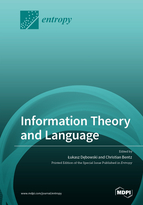Information Theory and Language
A special issue of Entropy (ISSN 1099-4300). This special issue belongs to the section "Multidisciplinary Applications".
Deadline for manuscript submissions: closed (31 October 2019) | Viewed by 56264
Special Issue Editors
Interests: information theory; natural language; ergodic theorems; hidden Markov process; long-range dependence; universal coding; Renyi entropies; recurrence times; subword complexity; repetitions; Kolmogorov complexity; algorithmic randomness
2. DFG Center for Advanced Studies, University of Tübingen, Rümelinstraße 23, D-72070 Tübingen, Germany
Interests: information theory; linguistic typology; language evolution
Special Issue Information
Dear Colleagues,
The historical roots of information theory lie in statistical investigations of communication in natural language during the 1950s. In the decades that followed, however, linguistics and information theory developed largely independently, due to influential non-probabilistic theories of language. Recently, statistical investigations into natural language(s) have gained momentum again, driven by progress in computational linguistics, machine learning, and cognitive science. These developments are reopening the communication channel between information theorists and language researchers. Both information theory and linguistics have made important discoveries since the 1950s. While the two frameworks have sometimes been framed as irreconcilable, we believe that they are fully compatible. We expect fruitful cross-fertilization between the two fields in the near future.
In this Special Issue, we invite researchers working at the interface of information theory and natural language to present their original and recent developments. Possible topics include but are not limited to the following:
- Applications of information-theoretic concepts to the research of natural language(s);
- Mathematical work in information theory inspired by natural language phenomena;
- Empirical and theoretical investigation of quantitative laws of natural language;
- Empirical and theoretical evaluation of statistical language models.
Dr. Łukasz Dębowski
Dr. Christian Bentz
Guest Editors
Manuscript Submission Information
Manuscripts should be submitted online at www.mdpi.com by registering and logging in to this website. Once you are registered, click here to go to the submission form. Manuscripts can be submitted until the deadline. All submissions that pass pre-check are peer-reviewed. Accepted papers will be published continuously in the journal (as soon as accepted) and will be listed together on the special issue website. Research articles, review articles as well as short communications are invited. For planned papers, a title and short abstract (about 100 words) can be sent to the Editorial Office for announcement on this website.
Submitted manuscripts should not have been published previously, nor be under consideration for publication elsewhere (except conference proceedings papers). All manuscripts are thoroughly refereed through a single-blind peer-review process. A guide for authors and other relevant information for submission of manuscripts is available on the Instructions for Authors page. Entropy is an international peer-reviewed open access monthly journal published by MDPI.
Please visit the Instructions for Authors page before submitting a manuscript. The Article Processing Charge (APC) for publication in this open access journal is 2600 CHF (Swiss Francs). Submitted papers should be well formatted and use good English. Authors may use MDPI's English editing service prior to publication or during author revisions.
Keywords
- natural language
- entropy
- mutual information
- entropy rate
- excess entropy
- maximal repetition
- power laws
- minimum description length
- statistical language models
- neural networks
- quantitative linguistics
- linguistic typology








